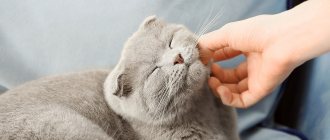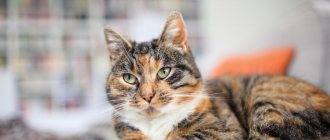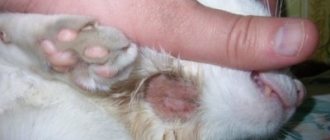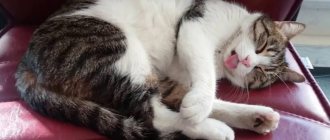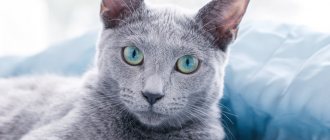Perhaps there is not a single indifferent person who would not be touched by the purring of a cat. It is this that gives the coziness that is so characteristic of cats. This contented, purring creature attracts mysterious, fascinated glances. Some owners suggest that in this way cats tell them bedtime stories and share their daytime adventures. In our article we will try to reveal in more detail such questions as why cats purr, and what physiological reasons allow them to do this.
Mechanism of sound occurrence
Why are the mechanics of a cat's purr still so poorly understood? The fact is that it is possible to determine for certain what and how cats purr only by dissection. But, of course, the dead don’t sing any “songs.” And modern diagnostic methods do not allow us to determine the origin of sounds.
It is known that there is no special organ for chirping sounds. This process definitely involves the vocal cords, the lungs, since “mur” sounds rhythmically, on inhalation and exhalation, and, possibly, the diaphragmatic and intercostal muscles. And - absolutely - the brain.
A cat's purring is a complex process that involves the lungs, muscles and brain.
Most researchers believe that cats purr through their throats. The vocal cords contract and the sound passing through them vibrates with each inhalation and exhalation. But what makes a cat do this? Question for neurophysiology. The “motor” is started by a mechanism in the brain.
Interesting fact: the comparison of a purring cat with a tractor is not accidental. At idle the car produces the same 15–150 Hz. Owners note that female cats purr louder than male cats.
There are alternative theories of the origin of uterine sounds:
- This is the sound of blood moving through the inferior vena cava, which carries venous blood to the heart.
- This is what the hyoid bones do.
- There are false vocal cords that are responsible only for these sounds.
- It was previously believed that vibrating sounds originated from the abdomen. But anyone who has petted a cat knows that this is not the case.
For now, the neurophysiological theory prevails: the need to vocalize breathing arises in the brain, and it already gives the command to the vocal cords. We hope that scientists will soon test the hypothesis and the age-old mystery will be revealed. In the meantime, let's figure out what causes the cat's brain to signal to the ligaments.
Most often, cats purr in a relaxed state, for example, on the owner's lap.
How do cats manage to purr?
There is still no one hundred percent answer to the questions: why cats purr loudly and how they do it.
However, there are several hypotheses regarding the origin of the rumbling process, which are accepted by scientists as possible. The most plausible theory is the presence of a hyoid bone .
Hyoid bone
According to recent research, rumbling occurs due to the presence of a hyoid bone in cats. Rumbling occurs in connection with the emotions experienced by the cat, which provoke the entry of a nerve impulse into the larynx, and it begins to shrink. This sets the said bone in motion when the cat breathes.
This theory is considered the most reliable, since rumbling is not observed in cats with laryngeal paralysis. Moreover, the type of rumbling depends on the shape of this bone.
Thus, domestic cats produce vibrating and pleasant sounds. The purring of a domestic cat is used in some areas of medicine to calm the nervous system and prepare the human body for heavy stress.
In cats, the bone has a triangular shape. In larger predators, for example, lions, the hyoid bone has the shape of a rectangle , which is why the rumbling sound is rougher, bassier and growling.
Lungs and diaphragm
Another theory is the work of the muscles of the diaphragm and ribs . When breathing, sound vibrations of different amplitudes are created. However, this theory can hardly be called reliable, since the intensity of purring in this case would have to change, which does not happen in real conditions.
False ligaments
Another theory is based on the work of the false cords, which are located directly above the vocal cords. According to the theory, rumbling occurs due to changes in pressure in the circulating bloodstream . Thus, vibration occurs in the chest and sound is transmitted to the sinuses.
What does a cat's purring mean?
Previously, it was believed that this is how animals communicate with each other and humans when they are stroked. However, “mur-mur-mur” is not only a means of communication and a way to express pleasure.
Method of communication
Kittens begin to purr already in the first days after birth. This is how they help mom find herself and feed her. With a person, everything works about the same. Animals wake people up, butt and purr loudly in the morning, especially if they spend the night in another room. “Good morning, master! It’s time to get up and feed me.” If your pet loudly “sings songs” in the kitchen (or where you usually feed your pet) and curls under your feet, meowing periodically, this is a direct hint of a desire to snack.
Surely you have noticed more than once that pets greet you stormily from work. At this moment, you can also hear a joyful “mrrr”.
Purring, the cat greets its human.
In relation to relatives, everything works exactly the same: a quiet sound indicates location. He warns others about a benevolent and good-natured attitude. This is also how animals encourage each other. Some scientists have noticed that wounded cats lie down next to each other.
Expression of pleasure
A satisfied cat - what could be more pleasant for the owner? Pets can actually express pleasure and even gratitude from tasty food, a secluded bed and warmth. Many pets love affection, and with the help of purring they express pleasure from stroking and scratching.
In combination with paw stomping, purring indicates peace and love. This means that your pet completely trusts you, is happy and feels as calm as she does next to her mother. After all, kittens’ little paws make “massage” movements to get more milk. Apparently, the memory remains with the animal forever, and pops up in moments of good mood. And besides, in this way the cat “marks” the owner.
Connection with nutrition
Remember that a kitten purrs so that the cat notices and feeds it? Echoes of this mechanism can be seen in the fact that many animals rumble when they eat. Perhaps from pleasure. Especially if it is SUPERPET - a species-typical food for cats and dogs according to the BARF system, developed by veterinarians and nutritionists. It replicates the diet of predators in nature: 98% consists of raw meat without heat treatment, flavor enhancers and preservatives. Biologically appropriate nutrition normalizes digestion, prevents urolithiasis, kidney disease and other ailments. And how delicious it is! Pets can only purr with pleasure.
For what reasons does a cat purr?
When answering why cats purr, many owners confidently say that the reason lies in positive emotions. This answer is correct, but incomplete. Sometimes purring is also triggered by negative emotions. You can only understand your pet's desires over time by remembering the difference in volume, duration and frequency of sounds.
Positive emotions
The ability to make a vibrating sound appears in kittens on the 2nd day after birth.
This is necessary to communicate with the mother. The purring of the babies indicates their satiety and good health, and the sounds emanating from the mother cat confirm the safety of her offspring.
In the wild, light vibrations are not detected by other predators, but are clearly perceptible to parents located at a long distance. This helps protect the litter until it becomes independent.
Among the positive emotions that awaken purring are:
- greeting the owner or communicating with other animals;
- going to bed before bed;
- gratitude for the treat or affection received;
- attracting the opposite sex;
- trying to beg for something tasty;
- interest in some object (delicious food) or object (a bird outside the window).
According to one version, cats purr to prevent muscle diseases that threaten them due to too much sleep. Vibrations spreading throughout the body have a positive effect on ligaments, bones and muscles, helping to reduce the load on the musculoskeletal system.
Negative emotions
Purring also occurs when a furry pet is under stress. The vibrations help him stabilize his blood pressure and bring his pulse back to normal.
Sometimes the reason lies in illness. Purring is a physiological pain reliever. It speeds up metabolism and promotes rapid regeneration. Try to observe how a cat purrs after sterilization: the frequency and volume of the sound will differ from usual until the end of rehabilitation.
One of the possible complications of coronavirus infection is feline infectious peritonitis. Its alternative name is “purring disease.” Due to damage to the blood vessels, some of the fluid enters the peritoneum and lungs, causing peritonitis. The bloating that appears is accompanied by a characteristic purring sound.
Also, mustachioed pets purr when their owner strokes them incorrectly or when a more formidable opponent tries to scare them. In the second case, they demonstrate their defenselessness, trying to avoid a possible fight.
Food for adult cats and kittens
Start shopping
Stress and pain
Cats begin to make purring sounds in different situations. It can be very stressful - right after having to run away from the dog. Or weak - when examining a new room. By purring, pets calm not only humans, but also themselves. Rhythmic sounds are a great way to relax.
There is a hypothesis that purring animals heal themselves. Vibration frequency from 20 to 150 Hz helps restore tissue, including bone, grow muscles, repair tendons and ease breathing. In their natural environment, animals have to sit in ambush for a long time when hunting and jump quickly, so it is important to maintain bone tissue in order.
Felines often purr when they fall asleep. It is possible that a large amount of sleep is also associated with the restoration of the body - up to 20 hours a day.
Loud purring for no apparent reason can be a signal to the owner that the cat is in pain. Especially if she sits with her eyes closed and her mustache drooping. Be careful: these animals endure pain until the last moment and hide their symptoms.
If a cat purrs in a tense position without closing its eyes, it is unlikely that it is feeling well at that moment.
During childbirth, cats also purr, helping themselves to overcome pain. Unfortunately, even before death, many of them make such sounds. Purring is very connected with physiological processes: appearing in the first days of life, it remains with the cat until the very last moments.
It is important to note that all cats are different, and they also vocalize their emotions differently. Some of them do not purr at all, while others trill constantly. And all these are variants of the norm. You can understand what your pet wants at the moment by her body language. A relaxed posture indicates pleasure, a tense one indicates that she wants something from you. An excited purr near a bowl is very different from what you hear when a furry dog curls up next to you.
When she gets what she wants, the purring stops. Think about the situations in which this happens and what the animal wants to tell you. Develop your powers of observation and you will be able to better understand your four-legged companion.
Cat “massage” with paws
There are various reasons why an animal gives its owner such a massage. Pets especially love to lie on the chest or gently stomp on it with their paws. There are several reasons why cats trample with their paws. The researchers explain this as follows:
- Childhood memories. Kittens often knead their mother when feeding, which brings them peace and pleasure. In adults, this behavior is usually observed after eating or sleeping.
- Preparation for sleep. They often like to sleep on their owner's lap, chest, or stomach. With this massage they seem to trample down the place for this.
- Thanks to the owner. With such movements one says “thank you” for food, warmth, affection, love.
- Medicinal purposes. This is one of the most common reasons for explanation that occurs in everyday life. It is worth knowing that there is no scientific evidence for this and it is a myth.
- Fighting stress. By moving their paws and purring at the same time, cats try to cheer themselves up, relax or calm down.
- Sexual instincts. According to one theory, such behavior appears when physiological needs are not fulfilled. This massage has an unambiguous meaning.
Good to know: why cats need scratching posts and how to choose the right one.
Cats may also mark their territory. On the paws there are special glands that secrete secretions. So it shows that this object belongs to him. This behavior is more typical for males. Often a cat massage indicates that it trusts its owner, loves him and shows him his trust in return.
Question to the expert
Should a cat be allowed to trample its owner's paws?
If the pet settles on the owner and makes such movements, it is not recommended to drive it away. Otherwise, contact between the animal and the person will be destroyed, and the pet will no longer trust him. A cat will reflexively pull its claws inward if you gently stroke the top of its paw.
Do big cats purr?
We have said more than once that the anatomy of a domestic cat is no different from the structure of a wild one. From a structural point of view, the gastrointestinal tract has not changed over millennia of evolution. What about neurophysiology and psychology?
Small cats - caracals, lynxes, cheetahs - purr like our domesticated pets. Although, of course, more often they hiss. Leopards, lions, panthers and tigers do not purr in the usual sense - they rather roar and make bass sounds. Their purr is more like a roar. But predators definitely use these techniques to communicate, when consuming food and expressing pleasure. There are videos online of cheetahs, tigers and pumas purring.
Interesting
There is an opinion that when cats purr, they can alleviate the condition of people during diseases such as depression, hypertension, and angina.
While the animal is purring, it is impossible to listen to either the heart or lungs. To stop the sound, veterinarians are forced to turn on the water and listen to the pet’s condition.
If a cat purrs loudly, then he is happy with life. When he says it quietly, he thereby attracts attention to himself, as if the pet is making a request.
A person, imitating a cat's "mur", does not copy tailed pets; at this time they pronounce the sounds: r, f, x, v, n, o, a, i, y, e.
Why your cat doesn't purr and what to do about it
Is it possible to make a cat purr? No, especially if she is not naturally inclined to do this. And that's okay: not everyone feels the need to express emotions by purring. There are even breeds that are not inclined to turn on their “engines” - Ragdolls and Devon Rex. Here, again, there are exceptions.
Getting a purr to do anything is very difficult in general, and with purring and other ways of expressing emotions it is even more difficult. This partly explains the impossibility of accurately diagnosing the mechanics of the appearance of iridescent sounds in predators. Nobody wants to purr in an MRI machine or during an ultrasound.
Sometimes this “insensitivity” is related to previous negative experiences. If the cat has been with bad owners or on the street, it may simply be afraid to show emotions by purring. You can try to help your cat make the desired sounds. Play with her, caress her, introduce treats into her diet (always natural) and demonstrate by your behavior that you are a safe person.
What are the benefits of purring?
There are opinions that purring has benefits and has a positive effect on the human body. The main ones are:
- soft sound with a special timbre, frequency 27-44 Hz, has a healing effect on the body;
- purring has a positive effect on the health and condition of bones;
- has a calming effect on a person;
- helps get rid of stress and relieve fatigue after work;
- sound vibrations affect human brain activity and help normalize blood pressure;
- a massage can be compared to an acupuncture session.
Some of these misconceptions have no scientific basis and are simple myths that have taken root in society. Having a cat in the house can have a positive impact on a child's development. According to statistics, children who had animals in childhood treat them better.
If a child has contact with a cat before the age of three, the allergens form a strong immunity to allergies. There are other statistics. People who have pets at home live on average 4-5 years longer than those who do not have pets.
The benefits of a cat's purring for humans
Our smaller furry brothers are real doctors. There is even feline therapy - treatment by communicating with cats. Pet owners cope better with stress, are less likely to become depressed, are more sociable and, in general, are healthier than people without pets. Why is purring useful?
Cats are furry physiotherapists. At a frequency of 25-50 Hz, bone tissue responds to purring, and at 100 Hz, skin and soft tissues respond. It's not as crazy as it may seem: the body's tissues respond to pressure by becoming stronger. Scientists even propose using this property of vibration for astronauts so that their bones do not lose their density in zero gravity.
A purring cat pleases the human heart. This means that having a pet in the home reduces the likelihood of having a stroke by a third. “Pur-mur-mur” is a kind of white noise, to which the owner calms down and falls asleep more easily.
Thus, not all purring kittens and cats are happy with their situation. A purring pet can feel both joy and pain. This amazing means of communication allows animals to communicate with each other and get what they want from humans. If a cat likes food or, conversely, is hungry, it will purr. This is done by domestic purrs, cheetahs, and pumas. But if your pet does not want to purr, this is also not a problem, and you can do nothing about it.
Cat-human interaction
The way a cat purrs depends on the person. A purring pet can trample its paws on its owner, lie down on top or next to it. All these actions have their explanation.
Showing affection
If you stroke your mustachioed pet, he will soon begin to purr. This means that he enjoys touch and communication with a person. When stroking against the grain or by a stranger, you can see the opposite effect. The animal will be angry or frightened and will hasten to leave with a threatening hiss.
Foot trampling
The most popular interpretation of trampling is the “milk step”. Kittens make similar movements on their mother's chest, stimulating the faster production of milk. Fingering with paws is also associated with:
- showing gratitude and demonstrating trust in a person;
- unrealized sexual instinct in castrated animals;
- treating the owner or relieving one’s own stress;
- preparing a comfortable place to sleep.
If your pet releases its claws when trampling, do not scold it. He does not control this action, so pet him and place a thick blanket or pillow under his paws.
Lying on or next to a person
Lying nearby is the highest form of trust and love. The animal feels safe with its two-legged owner. If a person is unwell, a furry pet can lie on top, sending its healing vibrations to the sore spot.
Cats purr when they fall asleep
Every animal lover could observe the process of a cat falling asleep with its own musical accompaniment, but not all people know that cats communicate with each other using purring. There is a stereotype that only people and dolphins consciously talk to each other. But that's not true. Cats talk to each other quite often. But they do it quietly. They only swear loudly. Expressing aggression, cats growl and meow loudly. But when they are friendly, animals do not use their voice. In a calm, peaceful environment, cats purr. For example, when a cat feeds kittens, she purrs, and the kittens purr back to her.
Reviews from owners about the purring of cats and cats
I have a peacemaker cat. As soon as someone raises their voice or starts screaming, she jumps into the arms of the one who is talking loudly and starts purring like a tractor. Everyone immediately laughs and no one swears anymore.
Marie
https://www.woman.ru/psycho/medley6/thread/4343692/
My cat fell from the 5th floor about 2 months ago. I sat in the basement for 2 weeks (I couldn’t find her). Now she runs, plays, eats a lot (before the fall she ate little), but she also constantly purrs, as if she was roaring! Previously she was very silent, you couldn’t hear a sound, but now it’s impossible to tolerate. He doesn't cry only when he sleeps.
matata
https://www.veterinar.ru/forum/viewtopic.php?id=2775
A week ago I bought a kitten that was taken from my mother. If I approach her when she is sleeping, she wakes up and purrs (caress me) and at the same time meows terribly (let me sleep!) Maybe she’s calling her mom? The rest of the day he behaves normally, as if he doesn’t know his mother. why is she acting like this
Sofiko
https://forum.kotodom.ru/topic2393.html
How purring occurs
The sound originates between the base of the skull and the base of the tongue. In the cat's brain, impulses arise that provoke contraction of the muscles near the vocal cords. The bones under the tongue create a vibration that spreads throughout the animal's body.
Their ability to purr depends on the structure of the hyoid bone of baleen animals. Domestic cats have a triangular-shaped bone, thanks to which they are able to purr continuously both when exhaling and inhaling. Large felines have a rectangular bone under the tongue. This allows them to make roaring sounds to intimidate and scare away enemies, but they can only rumble when exhaling.
Video with a visual demonstration of the anatomical causes of purring:
Many other animals make sounds similar to purring, such as guinea pigs, rabbits, raccoons and hyenas. But this cannot be called purring to the fullest extent. Only cats can truly do this.
Reference! While purring, it is impossible to listen to the animal's heart and lungs.
Purring expresses more than just happiness
Some cats purr when they are excited or nervous. It happens that a purr scratches its beloved owner if he misunderstands the cat’s emotional state.
It happens that a cat purrs at a veterinarian's appointment. This is how he shows his dependence and consoles himself as best he can.
Observe all signs of the cat’s psychological and emotional state:
Position of ears and tail. Follow his gaze. Pay attention to your general body position.
If he's lounging on his back, paws up, eyes closed and purring at full volume, rest assured, he's happily demonstrating his complete satisfaction with life.
The owner must learn not only to enjoy the singing of his cat, but also to understand why he purrs:
- Wants to say something.
- Show your mood.
- Give a sign that there is a problem.
- Report the onset of illness.
Mr. Cat recommends: interesting facts
Purring is a process unique to the animal world. But among the purring ones there are their own records:
- The volume of the rumbling varies in the range from 16 to 100 dts.
- The English cat Merlin purrs four times louder than an ordinary pet. The sound is so loud that it drowns out a running hair dryer. Eyewitnesses compare the cat's purring to the sound of a landing plane.
- The kitten makes its first “murr” at the age of two days.
- The most “purring” country in the world is Australia, where there is a cat for every resident.
1111
